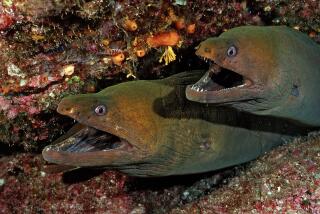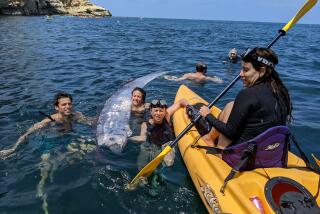A Long Way From Sri Lanka
- Share via
Talk about a fish out of water. A tropical moray eel native to the warm, southeast Asian waters off Sri Lanka was pulled from a chilly lagoon near Huntington Harbour on Tuesday.
Scuba-diving scientists trying to eradicate a toxic, alien seaweed from the lagoon were dismayed when they noticed the somewhat ragged-looking eel--clearly out of its element.
The listless, leopard-patterned eel was swimming toward shore when captured, probably trying to make its way to the warmer waters.
“He’s very beautiful, but it’s apparent that he’s also very stressed,” said Rachel Woodfield, a marine biologist with Merkel & Associates, a San Diego-based biological consulting firm. “He’s been kind of listing to his side. . . . You wouldn’t normally be able to capture a moray eel this easily.”
The scientists, who for weeks have been trying to eradicate a highly destructive strain of the invasive Caulerpa taxifolia seaweed that was probably dumped from an aquarium, said the discovery highlights a common problem: people tossing exotic species of animals, plants or other life forms from aquariums into a foreign environment.
Once animals grow too big, Woodfield said, many people simply dump them and the contents of their aquariums into the ocean, a lake or a pond.
Whoever dumped the eel into the lagoon probably thought they were doing it a favor but caused the animal a great deal of suffering, Woodfield said.
Since beginning the cleanup effort, the divers have discovered a diverse ecosystem of fish in the enclosed lagoon. Most, if not all, of the fish were probably dumped there by people, the scientists said.
Fortunately most of the animals, including goby, manta rays and yellowfin, are native to the nearby ocean, Woodfield said.
But the 2 1/2-foot, brilliantly dappled eel is used to water temperatures near 80 degrees, the scientist said.
“The water is freezing cold here,” Woodfield said. “If leaving this animal here is not bad for the environment, at least it’s bad for the animal.”
People have likely heard of goldfish dumped into rivers or baby alligators flushed down toilets. Even piranhas have been dumped into United States waters, but they die quickly, unused to waters much colder than the Amazon’s, Woodfield said.
The eel probably hasn’t been in the condominium-surrounded lagoon for more than a couple of days, Woodfield said. On Tuesday, the scientists spent the morning trying to find someone to take and care for the animal. Finally, Tong’s Tropical Fish & Pets in Fountain Valley agreed to pick the eel up and care for it.
“We’re going to keep it as a pet in a show tank,” said Soon Khamsue, an employee at the shop. “He’s going to be all right. When we picked the eel up, it was stressed and breathing really fast. But its breathing has been slowing down, and that’s a good thing.”
Although the scientists were glad to help, the discovery came at a time when they were already busy. Significant patches of the invasive seaweed--which can clone and spread to other parts of the ocean if even a single frond separates from the original stem--have recently been found not only in an adjoining lagoon but in nearby Huntington Harbour.
When the eradication began in October, the scientists thought the effort would be done by now. But with the new discoveries, the extremely sensitive eradication could stretch into February, Woodfield said.
More to Read
Sign up for Essential California
The most important California stories and recommendations in your inbox every morning.
You may occasionally receive promotional content from the Los Angeles Times.











